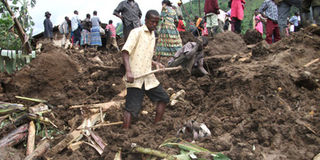Special Report: Bududa brought home nasty environmental lessons

DESTROYED: After landslides struck Mt. Elgon, the government was forced to relocate over 2000 people
Environmental conservation and protection has been one of the major challenges the world over. The green world has been attacked by both natural and artificial encroachers, leading to dangerous climatic changes, some of which have resulted in deadly disasters. Isaac Khisa looks back at 2010 and what the government is doing to stop degradation:-
Previously, Uganda never took seriously devastating effects of environmental degradation and climate change until March 2010 when cruel landslides occurred in the mountainous eastern district of Bududa, killing more than 300 people.
With the negative effects of environmental degradation and climate change, the government through its regulatory body, the National Environmental Management Authority (NEMA), vowed to take strict measures against environmental destroyers.
To show government commitment, it approved NEMA’s proposal last November to recruit 600 armed Environmental Protection Force (EPF) to guard forests and wetlands.
The recruitment of the 450 security personnel under NEMA and another batch of 150 under National Forestry Authority are already underway. The Force will be distributed across 12 regions in the entire country.
Dr Henry Aryamanya-Mugisha, NEMA’s executive director, said the Authority will use the new Force to demolish all the buildings constructed on the country’s wetlands starting this month. The force will also work with the Director of Public Prosecutions in prosecuting environmental degraders.
Demolition plans
Now with the new Force, buildings sitting on Kyetinda, Northern Mayanja, Nalukolongo, Lubigi and Kinawataka wetlands will be demolished, accompanied with immediate demarcation.
Wetland degraders have always chased NEMA officials whenever they intervened to stop construction on wetlands. Hope sense prevails this year.
Wetlands cover about 13 per cent of the total land surface area (about 30,000km2) of the country representing a considerable ecological, social and economic value.
In 1989, the government acknowledged that wetlands need to be conserved. However, the conservation has over time led to conflicts between the land owners who wanted to utilise their land for commercial purposes and the policy.
Continued wetland degradation has led to the emission of methane and carbon dioxide gases into the atmosphere exacerbating the effects of global warming.
Further, it is estimated that by 2020, the country’s natural forests which have been a centre for tourist attraction, climate change regulator and water catchment areas for most rivers and lakes, will be no more if measures are not taken to avert the current forest degradation.
Environmental experts say although the government, private sector and non-governmental organisations are working hard to restore forests through planting artificial ones, the natural forests - known to be the best regulator of climate change - are disappearing at an alarming rate.
According to the Ministry of Water and Environment, the country’s wood cover now stands at only 18 per cent down from 45 per cent since 1890 adding that tropical high forest in the country, in terms of number of species and trees, has also declined over time with over 30 per cent being classified as degraded.
It estimates that the costs of environmental degradation to Uganda’s economy stands high at 17 per cent of the Gross Domestic Product (GDP) of which 11 per cent is constituted by soil degradation estimated at $625 million (about Shs1.45 trillion) per annum. The loss of biodiversity is estimated at $240 million (about Shs557 billion) per year.
Montane forests in eastern and western Uganda have suffered from cultivators clearing the hillsides and transforming the land into agricultural land growing mainly bananas and beans as well as settlement.
The NEMA statistics also show that a minimum of 16,928 larger animal species are on the verge of extinction globally. These include mammals, birds, reptiles, amphibians and fish.
It adds that the abundance of fish species worldwide has declined by 40 per cent between 1970 and 2000. In the North Atlantic, fish has declined by 66 per cent in the last 50 years.
Environment Minister Maria Mutagamba said the government has failed to offer maximum protection to the natural forests because of the establishment of many environmental bodies and inadequate funds.
She says bodies like Uganda Wildlife Authority (UWA), NEMA and the National forestry Authority (NFA) need to be put under one ministry for easy coordination.
“Bodies like NFA and UWA are not harmonised,” Ms Mutagamba told Forest Conservators in Kampala last year. “Otherwise, the NFA Act cannot supervise what UWA, NGO’s and private sector are doing.”
She says the ministry has been weakened because it has no powers to follow up what happens in other bodies since they have their own management.
Although the government attributes deforestation to high population, NFA refutes the claim.
“Population growth contributes only three per cent of forest degradation in this country because of improvement in the agricultural sector through NAADS (National Agricultural and Advisory Services),” Mr Maxwell Kabi, a forest utilisation specialist at National Forestry Authority says, adding: “The remaining 97 per cent degradation is through low compliance, bad governance and demonisation of the forestry sector.”
He argues that heavily populated countries like China, India and United States would not be having forests if population growth was a threat.
According to the State of Environment Report 2008/9, 16 million tones of firewood are consumed per year as domestic firewood while another 4 million tones of charcoal are consumed per year.
High wood demand
The demand for timber is also expected to rise to 150,000 hectares by 2025 up from 80,000 hectares, according to the 2004 Forests Status Report by the European Union.
The Environmentalists argue that Uganda, just like other African countries, is likely to experience worsening global warming, landslides, reduction in water catchment areas, siltation of wetlands and reduced agricultural production if the trend is not be urgently addressed.
Already scientists proved that 2010 was the hottest year accompanied with increase in the carbon emission.
Ms Rachel Musoke, commissioner in the Ministry of Water and Environment, last year decried inadequate funding, adding that her ministry has only 12 technical staff, eight support staff and five old vehicles, making it hard to supervise all the forests.
Insufficient funding
She says over the last two financial years, the ministry has operated on an annual budget of Shs60 million for institutional structure, staff and other resources despite an increase in the number of districts to over 110.
In addition, 96 per cent of the planned budget in the forest sector will not be funded as stipulated in the five-year National Development Plan.
In the FY 2010/11, the Ministry of Finance, earmarked Shs34 billion towards the forest sector for restoration of the degraded forests and protection of critical and fragile ecosystem, reserve and mark forest boundaries as well as intensify forest activities in the forests.
Although the government and private individuals are involved in artificial tree planting, environmentalists have warned that the artificial trees simply worsen the problem of climate change.
They argue that some artificial trees absorb too much water from the soil whereas others do not release it into the atmosphere to promote water cycle unlike the indigenous. They add that artificial trees are not adaptable to the local condition.
However, with progress being registered in fighting climate change globally, delegates who gathered in Mexico for the United Nations climate change conference in November approved a package of measures aimed at slowing the emissions of climate-altering gases and at helping the poorest nations adapt to global warming.
According to the package, nearly 200 countries that participated in the conference including Uganda led by Ms Mutagamba, agreed for yet another year to decide whether to extend the frayed Kyoto Protocol, the 1997 agreement that requires most wealthy nations to trim their emissions while providing assistance to developing countries to pursue a cleaner energy future.
The agreement also set up a new fund to help poor countries adapt to climate impacts, create new mechanisms for transfer of technology, provide compensation for the preservation of tropical forests and strengthens the emissions reductions pledges that came out of the last United Nations climate change meeting in Copenhagen in 2009.
The deal comprised a “Green Climate Fund,” that reaffirms a goal of raising $100 billion in aid by 2020 and that has measures to protect tropical forests and new ways to share new clean energy technologies through which Uganda is set to benefit.
The Kyoto Protocol currently obliges almost 40 developed nations to cut emissions by an average of 5.2 percent below 1990 levels from 2008 to 2012.
Back at home, Uganda needs to walk the talk to combat climate change because it spares no tribe, rich or poor, religion or political party.




